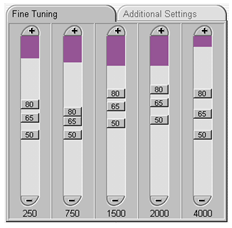Along with the evolution in digital hearing instrument technology comes a corresponding evolution in software fitting tools. As the number of channels and programmable parameters available in hearing instruments increases, fitting software becomes more complex and less intuitive. Software designers are continually confronted with the challenge of providing the hearing care professional with fine-tuning flexibility while keeping the software user friendly. Tools such as fitting assistants and fine-tuning guides are welcomed by many hearing care professionals. However there are some who still prefer to make adjustments manually. Bernafon has addressed this problem with the new TriQualizer™ control now available in our Neo product family.
The Neo design team sought to provide exceptional fitting flexibility for each of Neo's five channels of amplification, minimizing compromises in gain adjustment, without overloading the fitting software with compression controls. Our solution was the TriQualizer™—essentially an equalizer for 3 inputs at the same time! The handles control gain for soft, medium and loud sounds and permit different compression ratios between the inputs.
Adjusting compression often requires a series of compromises: If loud sounds are too loud the compression threshold can be decreased or the compression ratio increased, but both of these actions may carry an unwanted gain reduction for medium level sounds. An independent control is therefore especially useful for fine tuning the 65 dB input. Although this is probably the most important level to tune because it is the level of everyday speech, in many fitting systems the gain for the 65 dB input is a by-product of a compression ratio applied with a kneepoint below this level. The TriQualizer™ allows the hearing care professional direct control of this input.
The TriQualizer™ has several advantages:
- It is easy to adjust
- It provides an overview of the instrument response
- It clearly indicates interactions between different controls

Figure 1. OASIS plus Zoom View showing TriQualizer™ and the hearing instrument response.
How to use the TriQualizer™
Using the TriQualizer™ is easy and intuitive. This innovative tool is located in the Technical Toolbox in OASIS plus. To access the TriQualizer™, open the Technical Toolbox and click on the magnifying glass icon to open the Zoom View for the desired ear. The TriQualizer™ will appear in the Gain tab next to the response graph.
The TriQualizer™ has 5 sliders corresponding to the control frequencies for each of Neo's 5 channels. Each slider has three thumbs that can be adjusted independently or moved together.

Moving the controls upward increases the gain applied to the selected inputs in 2 dB steps (and therefore also the output), while moving the controls downward reduces the gain. Clicking on the plus and minus buttons located at the top and bottom of each channel will increase or decrease the gain applied to all input levels also in 2 dB steps.
Changing the MPO
The MPO controls for each channel are on the MPO tab, behind the gain tab. These controls are set when Oasis plus generates initial settings, however they can be adjusted by sliding the MPO handles up or down in each channel.
Integration
The TriQualizer™ sliders and the MPO controls are integrated. This means that movement of one control may cause another control to also move. The MPO provides a ceiling above which the output is held constant (output limiting). The 80 dB thumb may not be moved above the limit set by the MPO controls. The maximum range of the 80 dB thumb is indicated by a purple range at the top of each TriQualizer™ slider.
In some situations, the movement of a thumb in one slider may cause movement of another control. This insures that maximum fitting flexibility is available without compromising sound quality. It may happen within a channel, e.g. if the control for the 65 dB input is reduced to the point where the 50 dB control is, then the 50 dB control will begin to move with the 65 dB control. As well, controls in other channels may move, to maintain excellent sound quality and avoid extreme slopes. (This rule also applies to the MPO controls.) As a result, you may see other controls moving when you make an adjustment. But the thumb you are adjusting has priority over all the rest. This avoids the hassle of moving other controls "out of the way" before making your intended adjustment, as is required by some fitting software. The TriQualizer™ gives you the maximum freedom to make adjustments quickly and easily.
Information about amplification

Figure 2. Technical toolbox zoom view, highlighting the different sources of information about amplification.
There are three sets of information about the amplification. The first is an indication of the electronic gain - the amplified path. This does not include acoustic parameters such as venting or tubing. When the mouse is held over the TriQualizer™, the box directly below this tab will show the gain setting and compression ratio for that channel.
Additional information appears in the lower right hand corner of the response graph, in a tooltip that shows the frequency, input level and insertion gain for the input that is being adjusted. These values reflect the response in the graph, which shows the overall frequency response in the ear, taking all acoustic parameters into account. The graph and the values in the graph tooltip accurately reflect the combined response of the amplification and all acoustics (e.g. venting) in the ear. With this system, the hearing care professional knows exactly what changes are being made and how specific changes affect the overall response of the instrument.
Finally, a small tool tip appears whenever a thumb is moved up or down. This indicates the number of dB the control has been moved and the direction of the change (+ or -).
In order to maintain excellent sound quality, the TriQualizer™ offers compression ratios between 50 and 80 dB inputs ranging from linear to 5:1 compression but does NOT allow expansion which can damage sound quality if applied inappropriately. If reduction of low-level ambient noise is desired, Soft Noise Management is available to apply frequency-specific expansion to reduce soft sounds. Separate control of expansion ensures optimum performance of the instrument.
The TriQualizer™ is another innovative solution offered by Bernafon. We are confident that this new tool will simplify fine-tuning while still allowing the hearing care professional full control over the important parameters of the hearing instrument response.
For more information, visit the Bernafon website.

